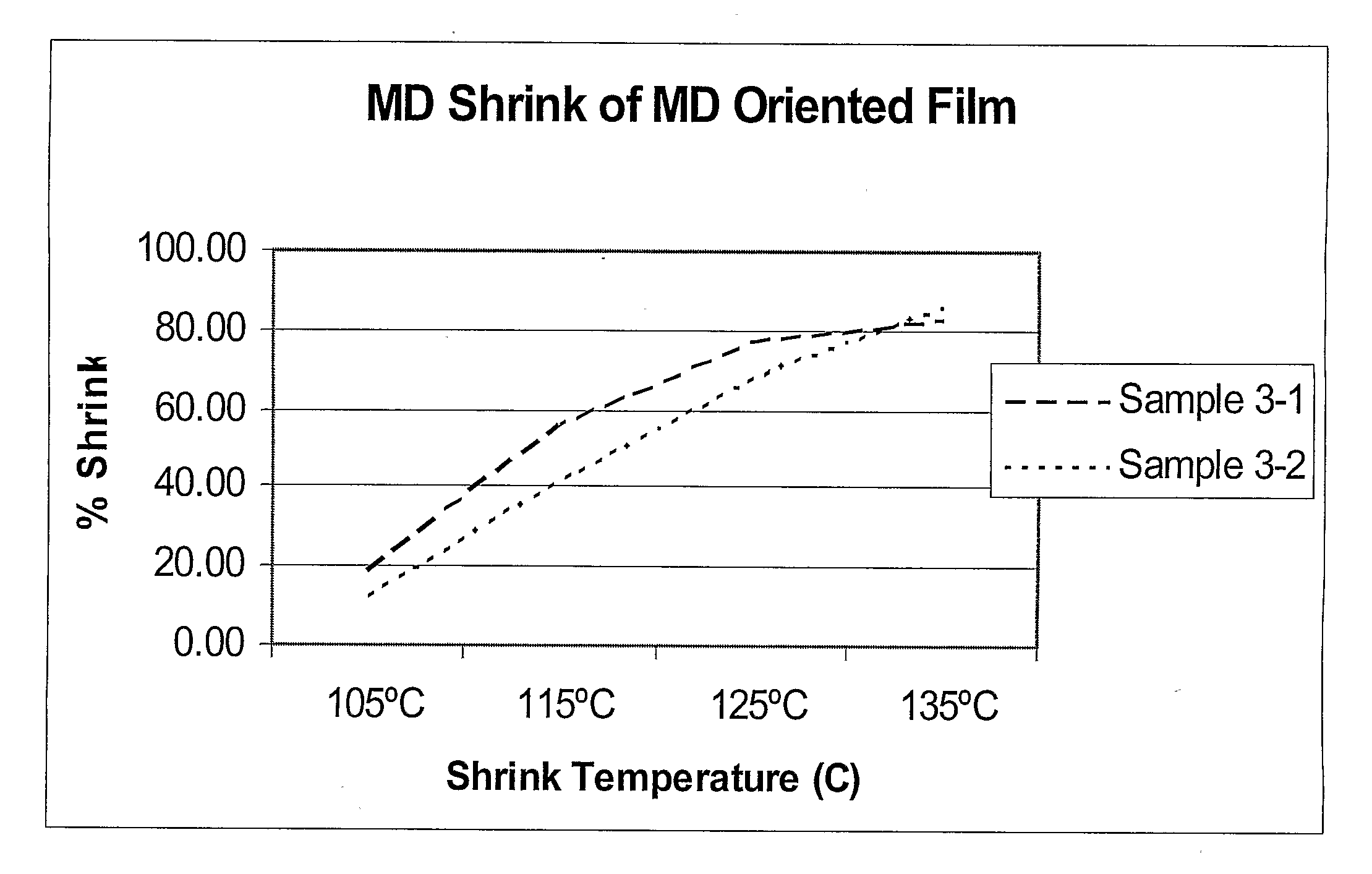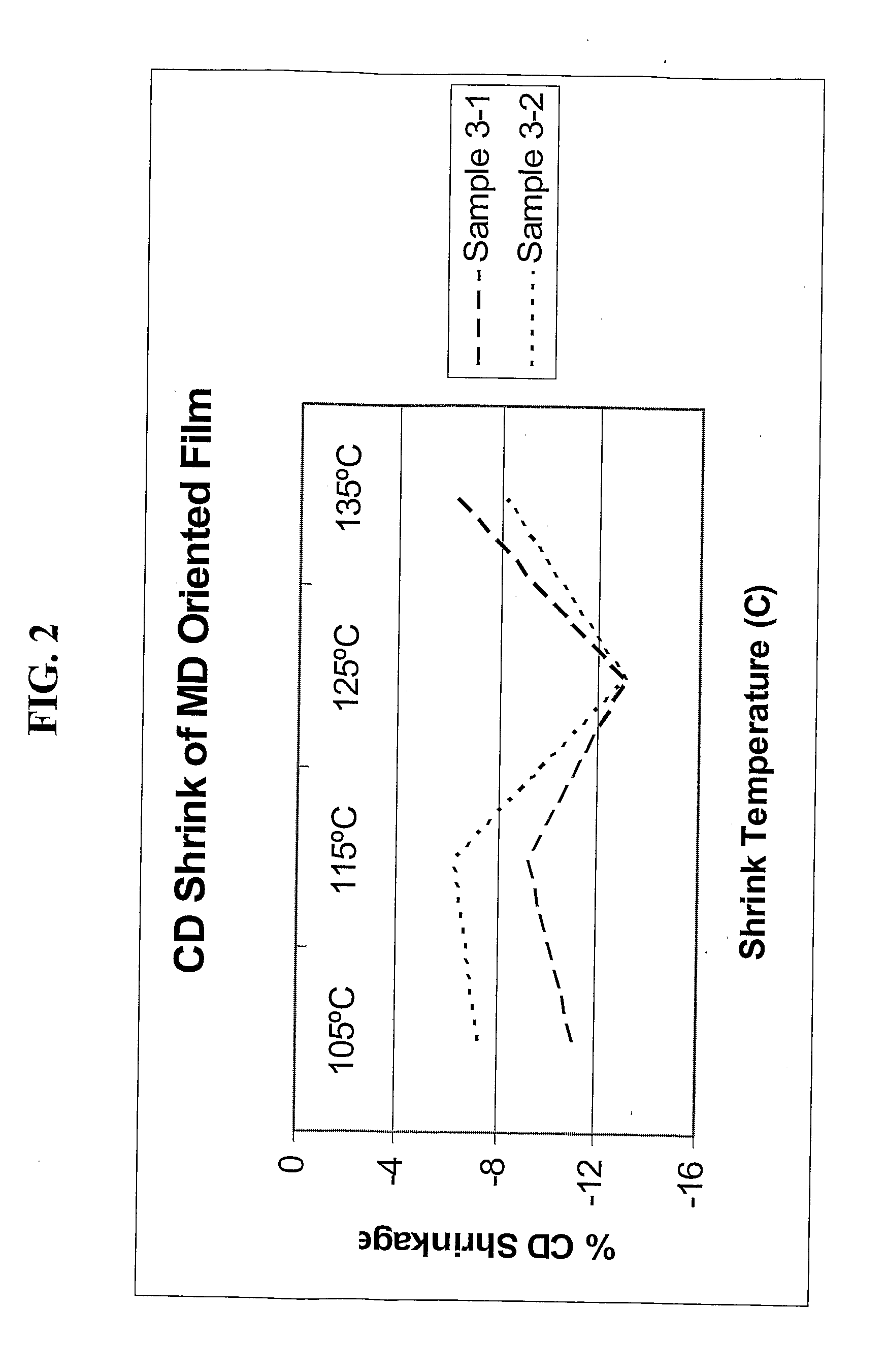Oriented multi-layer shrink labels
a multi-layer film and orienting technology, applied in the direction of identification means, liquid handling, instruments, etc., can solve the problems of increasing the manufacturing cost of sleeve labels relative to roso labels, complicated manufacturing process, and high cost of orienting films in the td for sleeve labels, so as to facilitate the printing of roso labels and shrink tension
- Summary
- Abstract
- Description
- Claims
- Application Information
AI Technical Summary
Benefits of technology
Problems solved by technology
Method used
Image
Examples
example 1
[0057]Skin layers, each at about 25 wt percent of overall film structure, are made from Styron™ 668 GPPS (density=1.05 g / cc, MFR=5.5 g / 10 min (5 kg / 200° C.)). Tie-layers, each at about 12 wt percent of the overall film structure, are made from KRATON G1730M (density=0.90 g / cc; MI=13 g / 10 min(5 kg / 230° C.)). The core layer is a developmental propylene plastomer of the type described in WO03 / 040442 having 5 wt percent ethylene and a melt flow rate of 8 g / 10 min (ASTM D1238, 230° C., 2.16 kg) and a density of 0.888 g / cc. The core layer is about 26 percent of the total structure. The calculated density of the film is about 0.974 gm / cc. The average total film thickness before the orientation step is about 112 microns.
example 2
[0058]Skin layers, each at about 21 wt percent of overall film structure, are made from Styron™ 668 GPPS. Tie-layers, each at about 12 wt percent of the overall film structure, are made from KRATON G1730M. The core layer is a developmental propylene plastomer of the type described in WO03 / 040442 having 5 wt percent ethylene and a melt flow rate of 8 g / 10 min (ASTM D1238 230° C., 2.16 kg), and a density of 0.888 g / cc. The core layer is about 34 percent of the total structure. The calculated density of the film is about 0.961 gm / cc. The average total film thickness before the orientation step is about 124 microns.
[0059]The film extrusion conditions for each Example are shown in Table I:
TABLE IExample 1Example 2Layer:SkinCoreCoreTieSkinCoreCoreTieLayersLayerLayerLayersLayersLayerLayerLayersExtruder no.12341234Screw RPM5424201235304015Drive amps3810.55815Barrel Pressure (Psi)19501300173032742070153022903670Barrel Zone 1 (F.)350380380350350380380350Barrel Zone 2 (F.)375435435390375435435...
example 3
[0062]Another five layer structure was prepared. The skin layers are provided by Extruder A and C in this extrusion system and are each 15 wt percent of the overall film structure. These layers are made from a dry blend of 70 percent STYRON 668 GPPS and 30 percent K-Resin styrene-butadiene copolymer DK11 (available from Chevron Phillips). The tie layers are each 10 wt percent of the total film structure and are provided by Extruder D. The tie layers are made from KRATON G1730M. The core layer is 50 wt percent of the total film structure and is provided by Extruder B in this system. The core layer is a developmental propylene plastomer of the type described in WO03 / 040442 having 5 wt percent ethylene and a melt flow rate of 8 g / 10 min. (ASTM D1238, 230 C, 2.6 kg) and a density of 0.888 g / cc.
[0063]Orientation is done in the machine direction using variable speed rolls to impart various levels of orientation as set forth in Sample 3-1 and 3-2.
[0064]Process conditions are set forth in T...
PUM
| Property | Measurement | Unit |
|---|---|---|
| density | aaaaa | aaaaa |
| density | aaaaa | aaaaa |
| particle size | aaaaa | aaaaa |
Abstract
Description
Claims
Application Information
 Login to View More
Login to View More - R&D
- Intellectual Property
- Life Sciences
- Materials
- Tech Scout
- Unparalleled Data Quality
- Higher Quality Content
- 60% Fewer Hallucinations
Browse by: Latest US Patents, China's latest patents, Technical Efficacy Thesaurus, Application Domain, Technology Topic, Popular Technical Reports.
© 2025 PatSnap. All rights reserved.Legal|Privacy policy|Modern Slavery Act Transparency Statement|Sitemap|About US| Contact US: help@patsnap.com



